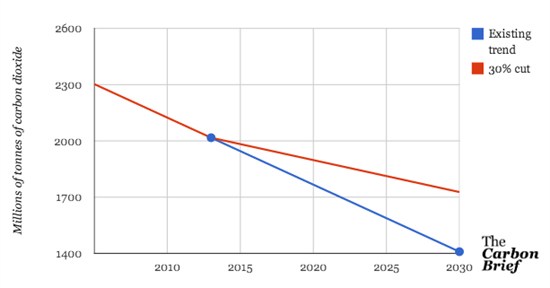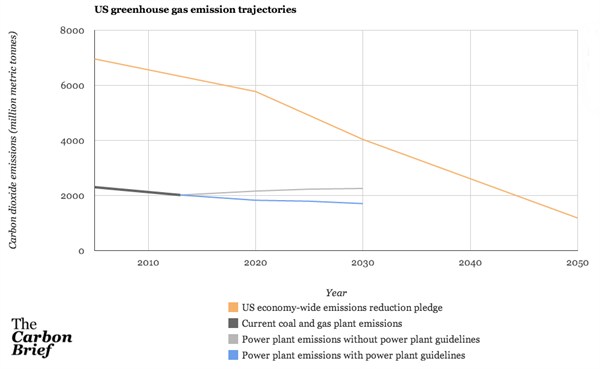Simon Evans
02.06.2014 | 3:35pmToday marks President Obama’s boldest attempt yet to tackle US greenhouse gas emissions. At his request, the US Environmental Protection Agency has published a Clean Power Plan to cut emissions from coal and gas plants.
What is the plan?
The plan aims to cut the emissions of the US power sector 30 per cent on 2005 levels over the next sixteen years. It is open for comment for 120 days and the EPA aims to have final rules in force by June 2015.
Each state in the US will be set their own target for emissions per megawatt hour of electricity produced. States will have until 30 June 2016 to submit plans explaining how they will meet this target. The EPA says it might allow states to plead for up to two years’ extra time.
The proposal covers emissions from 1,600 existing coal and gas-fired power stations across the US. Regulations limiting emissions from new power stations are already in the pipeline.
Why is President Obama doing this?
President Obama has pledged to cut US emissions by 17 per cent of 2005 levels by 2020, 42 per cent by 2030 and 83 per cent by 2050.
The Clean Power Plan does not increase US climate ambition but it does give Obama a better chance of meeting his existing pledges.
He has tried to get the US Congress to pass cap-and-trade laws to regulate emissions before, but every time he has been rebuffed by his political opponents.
He is now relying on executive powers that bypass Congress, and allow the EPA to regulate power sector emissions directly.
The effort is part of Obama’s wider Climate Action Plan, launched last year.
What will it achieve?
Coal and gas-fired electric plants are the biggest source of emissions in the US, responsible for around 38 per cent of the country’s total emissions. Emissions from coal and gas-fired electric plants were 2,303 million tonnes in 2005. A 30 per cent cut would amount to 691 million tonnes – that’s more than the 590 million tonnes emitted by the entire UK economy in 2013.
So if Obama can’t tackle these sources any hopes of delivering on his climate pledges will surely fail.
The EPA predicts that its plan will reduce coal’s share of electricity generation from 37 per cent today down to 30 per cent in 2030.
Total US carbon dioxide emissions from energy use – power, transport and heat – were 5,393 million tonnes in 2013. Energy use accounted for 86 per cent of all US greenhouse gas emissions in 2011 and a similar proportion in 1990.
The planned rules only address the power sector. That means that, if achieved in full, they would only reduce total US greenhouse gas emissions 10 per cent by 2030 compared with 2005. This would be a significant but not large part of Obama’s promised 42 per cent cut in emissions by 2030.
The rules are also unlikely to make a big contribution to meeting the 2020 pledge of a 17 per cent cut, because states won’t start implementing their plans until 2017 at the earliest, even assuming there are no legal hiccups.
Notably, by the end of 2013, US coal and gas electric emissions had already fallen by 286 million tonnes (12 per cent) since 2005. As well as the global economic downturn, these years have witnessed a seismic shift in the US energy landscape with the rise of shale gas displacing higher-emitting coal power.
If the 2005-2013 trend were to continue to 2030, power sector emissions would fall by 39 per cent, Carbon Brief analysis suggests. If that is a reasonable expectation, then the Obama plan is much less ambitious than recent business as usual.

What is the legal situation?
The proposed rules are based on the Clean Air Act, and a 2007 finding that greenhouse gas emissions threaten the public health and welfare of current and future generations.
The EPA’s authority to regulate greenhouse gas emissions has survived legal attacks so far but today’s plans open up new legal uncertainty and are certain to be subject to further challenge.
That’s because the agency wants to allow flexibility in how the targets are met. It is not requiring states to set limits for individual power plants, because they could not be met without fitting expensive and untested carbon capture and storage facilities, or simply closing down.
Instead it wants to set targets for the power sector at state level. Some US states have very good records of recent electric sector decarbonisation. Others still generate most of their power using coal. So the EPA’s level of ambition for each state varies.
States can choose from a flexible menu in order to meet their targets. This could include plant closures, CCS, energy efficiency, renewables, carbon trading – or a combination. This means the EPA is, in effect, not just regulating power plants but providing a broader framework for emissions reduction.
There is no legal precedent for it to use the Clean Air Act in this way. The Ohio attorney general has ” vowed” to challenge the EPA’s plans. Legal opinions differ on the EPA’s authority.
Olga Christyakova, senior analyst at Thomson Reuters Point Carbon says:
“I think the EPA knows how to buffer their legal arguments given its experience with earlier legal challenges. They will be drafting this to be legal-proof.”
The EPA’s authority to regulate emissions could be taken away by the US Congress. Senate Republicans have already said they will try to do this. However, it would need support from every Republican senator and 22 Democrats in order to override a presidential veto.
That balance of power could shift after mid-term elections due this autumn.
There is also a presidential election coming up in 2016. Obama has instructed the EPA to finalise its rules by June 2015 so that they are in place before he leaves office. But the EPA rules on new power plants have been subject to several delays and have still not entered force even though they were initiated in March 2011.
That means the new plans are unlikely to have been implemented and brought into force before the presidential election. An unsympathetic new White House incumbent could pull the plug.
What does it mean for the rest of the world?
UN climate chief Christiana Figueres said in a statement “I fully expect action by the United States to spur others in taking concrete action”. For instance, Canadian premier Stephen Harper has said he will only tackle emissions “in concert with” the US.
EU climate commissioner Connie Hedegaard said the proposed rules were ”the strongest action ever taken by the US government to fight climate change.”
Some climate negotiators have told the New York Times that they think the plan is a big deal. Former UN climate chief Yvo de Boer thinks so too. Many papers are reporting that the deal could give the US more leverage at international climate talks and improve the chances of a global climate deal in Paris next year. Much of this is speculation.
Tell me more?
News analysis site Vox has a good overview of the plan. For a really detailed discussion of the challenges it will face, read this from the Center for Climate and Energy Solutions.


